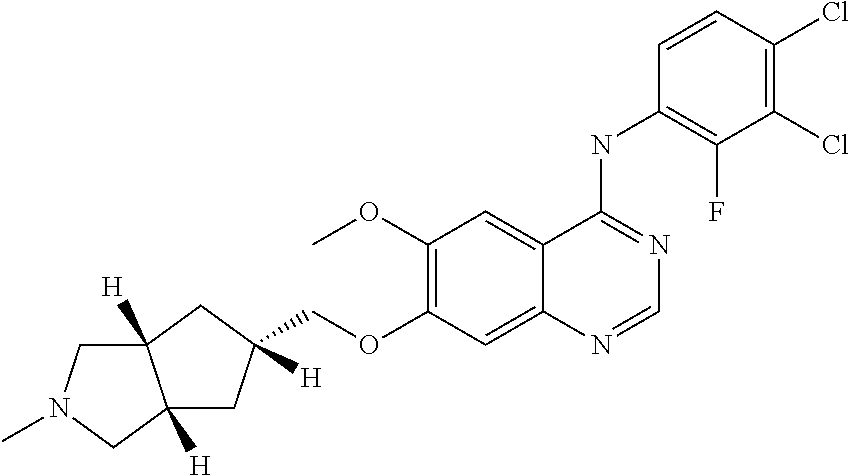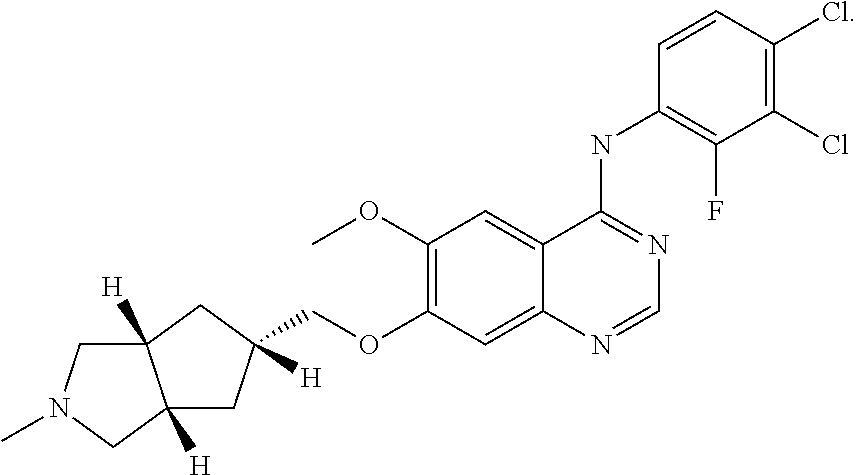Use of a Receptor-Type Kinase Modulator for Treating Polycystic Kidney Disease
- Summary
- Abstract
- Description
- Claims
- Application Information
AI Technical Summary
Benefits of technology
Problems solved by technology
Method used
Image
Examples
example 1
BPK Model of ARPKD
[0080]The effectiveness of XL-647 in treating ARPKD was tested using the BPK model of ARPKD. bpk mice have a BALB / c background, and contain the same mutation in the EGFR gene that is seen in murine and human ADPKD. These animals were housed in Medical College of Wisconsin vivarium facilities. All animal experiments were conducted in accordance with policies of the NIH Guide for the Care and Use of Laboratory Animals and the Institutional Animal Care and Use Committee of the Medical College of Wisconsin.
[0081]Beginning on post-natal day 7 (PN-7), entire litters from proven bpk heterozygous breeders include homozygous (diseased) as well as heterozygous and wild type animals were injected with XL-647 dosed every other day at 7.5 or 15 mg / kg or every day at 15 mg / kg. Animals were treated from PN-7 through PN-21 and evaluated for extent of disease. The identity of bpk + / + animals can be readily determined post-mortem by the presence of greatly enlarged kidneys. On PN-21...
example 2
PCK Model
[0085]XL-647 was used in the PCK rat model, an orthologous model of ARPKD, to determine its effectiveness in inhibiting ErbB2. The phenotype of the PCK rat is different from that of humans in that it has a slower disease progression and slower decline in renal function. The PCK rats came from a mutated colony of Sprague-Dawley rats from Fujita Health University and were housed at the Medical College of Wisconsin. All animal experiments were conducted in accordance with policies of the NIH Guide for the Care and Use of Laboratory Animals and the Institutional Animal Care and Use Committee of the Medical College of Wisconsin.
[0086]From PN30 to PN 90, PCK (diseased) rats received XL-647 at 7.5 mg / kg / q.d. and 15 mg / kg / q.d. by gavage. Two hours after last injection on PN90 the rats were sacrificed and the kidneys and liver were removed and weighed. Post-mortem measurements included KW / BW ratio and cystic index (CI) using renal sections from the cortex, medulla, and papilla. CT-C...
example 3
In Vitro Biochemical Screen for Specificity of XL-647
[0095]The specificity of XL-647 was assessed against a panel of pharmacological targets, including receptors, transporters, and enzymes (NovaScreen, Hanover, Md.). At a single in vitro concentration of 10 μM, XL-647 was shown to interact with very few of the pharmacological targets (Table 7). Only the human serotonin transporter was inhibited with an IC5050=188 nM). Effects were also observed at muscarinic receptors, α2-adrenergic receptor and dopamine transporter, which exhibited IC50 values of 1-2.7 μM.
TABLE 7NovaScreen Assay Panel Against XL-647Inhibition,Target Assay10 μM XL-647IC50 (nM)Adenosine, Non-selective47.89%Adrenergic, Alpha 1, Non-selective49.40%Adrenergic, Alpha 2, Non-selective84.56%1800Adrenergic, Beta, Non-selective18.01%Dopamine Transporter87.14%2480Dopamine, Non-selective34.88%GABA A, Agonist Site1.07%GABA-B*−1.19%Glutamate, AMPA Site10.79%Glutamate, Kainate Site0.89%Glutamate, NMDA Agonist Site−1.66%Glutamate,...
PUM
| Property | Measurement | Unit |
|---|---|---|
| Mass | aaaaa | aaaaa |
| Mass | aaaaa | aaaaa |
| Mass | aaaaa | aaaaa |
Abstract
Description
Claims
Application Information
 Login to View More
Login to View More - R&D
- Intellectual Property
- Life Sciences
- Materials
- Tech Scout
- Unparalleled Data Quality
- Higher Quality Content
- 60% Fewer Hallucinations
Browse by: Latest US Patents, China's latest patents, Technical Efficacy Thesaurus, Application Domain, Technology Topic, Popular Technical Reports.
© 2025 PatSnap. All rights reserved.Legal|Privacy policy|Modern Slavery Act Transparency Statement|Sitemap|About US| Contact US: help@patsnap.com



